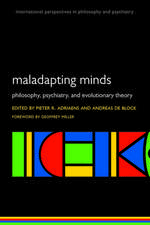The Biological Basis of Schizophrenia
Editat de G. Hemmings, W.A. Hemmingsen Limba Engleză Paperback – 3 apr 2012
Preț: 367.47 lei
Preț vechi: 386.81 lei
-5% Nou
Puncte Express: 551
Preț estimativ în valută:
70.34€ • 76.43$ • 59.12£
70.34€ • 76.43$ • 59.12£
Carte tipărită la comandă
Livrare economică 21 aprilie-05 mai
Preluare comenzi: 021 569.72.76
Specificații
ISBN-13: 9789401162081
ISBN-10: 9401162085
Pagini: 288
Ilustrații: 272 p.
Dimensiuni: 152 x 229 x 15 mm
Greutate: 0.39 kg
Ediția:Softcover reprint of the original 1st ed. 1978
Editura: SPRINGER NETHERLANDS
Colecția Springer
Locul publicării:Dordrecht, Netherlands
ISBN-10: 9401162085
Pagini: 288
Ilustrații: 272 p.
Dimensiuni: 152 x 229 x 15 mm
Greutate: 0.39 kg
Ediția:Softcover reprint of the original 1st ed. 1978
Editura: SPRINGER NETHERLANDS
Colecția Springer
Locul publicării:Dordrecht, Netherlands
Public țintă
ResearchCuprins
Section 1: Structure.- 1 The brain stem reticular formation.- Section 2: Genetics.- 2 Clinical and biochemical manifestations of acute intermittent porphyria: a working model for schizophrenia as an inborn error of metabolism.- Section 3: Pathogenesis.- 3 Psychoses from digestive origins.- 4 The amino hepato-entero-toxic theory of schizophrenia: an historical evaluation.- 5 Clues to the causation of schizophrenia.- 6 An evaluation of the dopamine hypothesis of schizophrenia.- 7 The dopamine hypothesis revisited.- 8 Tryptophan and serotonin in schizophrenia: a clue to biochemical defects?.- 9 Neurochemical findings in the post-mortem schizophrenic brain.- 10 The pineal gland: its possible significance in schizophrenia.- Section 4: Treatment.- 11 Rational drug treatment in schizophrenia.- 12 Investigations into serum folate and B12 concentrations in psychiatric in-patients with particular reference to schizophrenia.- 13 Propranolol and schizophrenia: objective evidence of efficacy.- Section 5: Dietary Factors.- 14 The effect of diet on brain neurotransmitters.- 15 Schizophrenia: Are some food-derived polypeptides pathogenic? Coeliac disease as a model.- 16 Some insights into the pathogenesis of schizophrenia.- 17 Nutrition and schizophrenia: implications and problems.- 18 The cytotoxic properties of wheat proteins.- 19 5-Hydroxytryptamine metabolism in coeliac disease.- 20 A preliminary investigation of dietary constituents and amphetamine-induced abnormal behaviour.- Section 6: Immunological Factors.- 21 Immunobiological approaches to the study of gut function.- 22 Nutrition and immunity: possible new approaches to research in schizophrenia.- 23 The absorption of large breakdown products of dietary proteins into the body tissues including brain.- 24 Antibodies to gliadinin serum of normals, coeliac patients and schizophrenics.- Section 7: Alcoholism.- 25 Screening tests for alcoholism.











